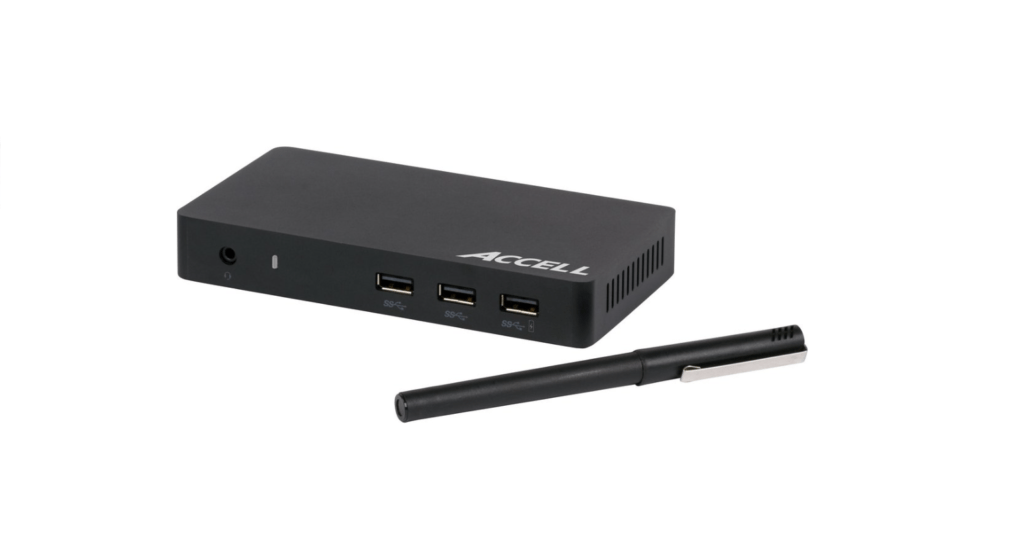I love using ultrabooks and 2-in-1 laptops as my primary computing device. They make it easy to take my computer from one location to another or compute on the go. When I am sitting at my desk, though, effectively using the device as a “desktop PC”, the lack of ports and connections on a small, thin laptop or 2-in-1 quickly becomes an issue. That’s where something like the Accell USB Docking Station comes in handy.
Form
The Accell USB Docking Station is fairly compact. It is a small, black rectangle that is 6 inches wide, 1 inch tall, and just over 3 inches deep. The unit weighs 9.7 ounces.
On the front and back, there are a variety of ports available: DisplayPort, HDMI 1.3, 3 USB 3.0 ports—one is also Battery Charging 1.2 enabled to support up to 1.5A of power for rapid charging of devices. It also has a Gigabit ethernet port and a 3.5mm audio / microphone jack.
It comes with the dock itself, an AC power adapter, a 2-foot USB to USB cable to connect the dock to your computer, and a user manual.
Function
The function of the device is simple enough. You plug it in to power and connect the USB cable to your computer. Voila! Your computer now has access to all of the various ports and connections, and you only had to connect a single USB cable.
There are some system requirements—but they shouldn’t be a problem for 99.99 percent of computers currently in use. The computer you connect to the dock must be running Windows 7 or newer, or MacOS 10.6 through 10.11. The computer must also have at least 4GB or RAM and compatible graphics (IntelHD4000, ATI Radeon HD5000 / AMD Radeon HD6000, NVIDIA GeForce400M or better). Obviously, the computer you connect to must also have a USB port to connect the dock to.
The dock is set up so the AC power, USB connection to your computer, display connections and ethernet are on the back side, while the front provides easy access to the three USB ports and the audio jack, so you can connect and disconnect things without having to get behind the dock every time.
My Experience
My main computer is a Surface Pro. It is very thin and light by design—so it doesn’t have very many ports. In theory, I could connect speakers to the audio port on one side and connect a display to the mini DisplayPort and a USB hub of some sort to the USB port on the other side. However, that would be a pain in the ass to connect and disconnect every time I want to use the Surface Pro at my desk, and it would create a tangled mess of cords running everywhere.
I prefer the simplicity of a dock.
Using the Accell USB Docking Station, I was also able to create a multi-display set-up. I connected one monitor to the DisplayPort on the dock, and another monitor to the HDMI port, then I use the Surface Pro in the middle—resulting in a triple-monitor configuration.
I use a wireless mouse at my desk, but my keyboard connects to a USB port. So does my webcam…and my wireless headset. Using this dock, I determined that three USB ports is essentially the bare minimum I can function with, but four or five would be better because three doesn’t leave me with any available for connecting a USB thumb drive or some other device without either connecting a USB hub to one of the ports or disconnecting some other device I am using.
I also understand why the audio port is on the front for easy access to connect or disconnect headphones. However, I use the dock to create a desktop PC experience, so the audio jack is connected to PC speakers in my case. I would rather have the audio connection on the back side of the dock, because I don’t like having the cable come around and stick out of the front. It’s a very minor thing, but it’s a thing.
The Verdict
This is a great device. It is simple and does what you want and need it to. With the exception of wishing for an additional USB port and moving the audio jack to the back, I don’t have any issues or complaints.
The Accell USB Docking Station is listed for $191.99 on the Accell website. By itself, that sounds like a lot. I mean, it would be more complicated and less aesthetically pleasing, but I can accomplish essentially the same thing by just connecting a $10 USB hub to my Surface Pro and using the ports that already exist on the device.
When you consider that the Surface Dock is $200, though, it seems more reasonable. For a Surface device, I would still recommend the Surface Dock. The extra $8 gets you a fourth USB port, and you connect the dock and power through the one Surface Connect cable connection—so you’re also leaving the USB port on the Surface itself free. But, for any other computer, the Accell USB Docking Station is an excellent choice.
- Semperis Confronts the Identity Chaos Exposed by AI Search - December 11, 2025
- The Identity Problem No One Saw Coming—Until AI Exposed It - December 11, 2025
- Cyware’s AI Fabric Pushes Agentic Automation From Concept to Practical Reality - December 8, 2025



